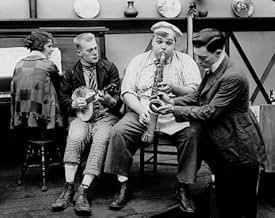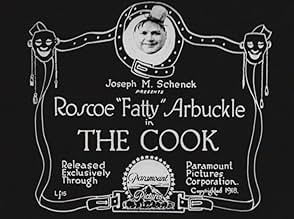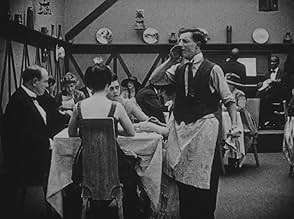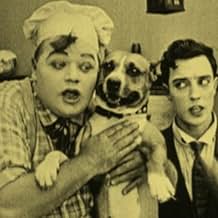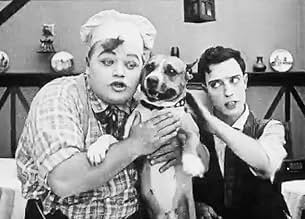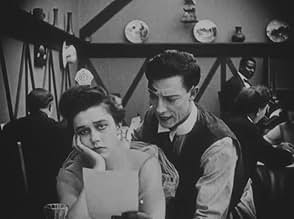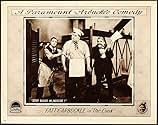The Cook
- 1918
- 22min
CALIFICACIÓN DE IMDb
6.6/10
2.1 k
TU CALIFICACIÓN
Agrega una trama en tu idiomaChaos reigns at an upscale restaurant as a cook and a waiter juggle their responsibilities.Chaos reigns at an upscale restaurant as a cook and a waiter juggle their responsibilities.Chaos reigns at an upscale restaurant as a cook and a waiter juggle their responsibilities.
- Dirección
- Guionista
- Elenco
- Dirección
- Guionista
- Todo el elenco y el equipo
- Producción, taquilla y más en IMDbPro
Opiniones destacadas
The pairing of Buster Keaton and Roscoe Arbuckle was fast becoming the most popular attraction on the movie screen in 1918. Fans flocked to the theaters in droves to witness the latest antics of the two genius comedians. Once the call for Americans to volunteer for the Great War kicked in earnest, Keaton decided to enlist in the United States Army. His reporting date for training at Camp Kearney, California, was July 24, 1918.
Before leaving, Keaton filmed what would be his final movie for several months, "The Cook," released in September 1918. Taking elements from his earlier 1916 "The Waiter's Ball," Arbuckle returned to familiar grounds of being a cook in a restaurant while expanding upon scenes in an amusement park. "The Cook" also served as showcase for one of the first inside jokes of a parody from a recent popular film, Theda Bara's "Cleopatra" of the previous year. Fatty dresses up like the Egyptian queen using kitchen implements and imitates Bara's emotional death scene by taking a long string of sausages, symbolizing an asp, and applying the end of the link onto his breast underneath a frying pan. Frustrated by the ineffectual poison of the meat, Arbuckle proceeds to eat the entire sausage link.
Keaton was shipped out to Europe after his training session in California. During his tour overseas, he slept in drafty tents, resulting in deafness in one ear. When the war was over in November 1918, the Army brass decided to keep the film star in Europe to entertain the remaining troops. His most popular act was "The Snake Dance," where Buster was dressed as an Egyptian dancer engaging with Theo The Snake--a long length of link sausage. If that sounds familiar, the sequence is exactly what appeared in "The Cook" when Keaton was dancing with Arbuckle in the kitchen appearing as ancient hopalong Egyptians.
Before leaving, Keaton filmed what would be his final movie for several months, "The Cook," released in September 1918. Taking elements from his earlier 1916 "The Waiter's Ball," Arbuckle returned to familiar grounds of being a cook in a restaurant while expanding upon scenes in an amusement park. "The Cook" also served as showcase for one of the first inside jokes of a parody from a recent popular film, Theda Bara's "Cleopatra" of the previous year. Fatty dresses up like the Egyptian queen using kitchen implements and imitates Bara's emotional death scene by taking a long string of sausages, symbolizing an asp, and applying the end of the link onto his breast underneath a frying pan. Frustrated by the ineffectual poison of the meat, Arbuckle proceeds to eat the entire sausage link.
Keaton was shipped out to Europe after his training session in California. During his tour overseas, he slept in drafty tents, resulting in deafness in one ear. When the war was over in November 1918, the Army brass decided to keep the film star in Europe to entertain the remaining troops. His most popular act was "The Snake Dance," where Buster was dressed as an Egyptian dancer engaging with Theo The Snake--a long length of link sausage. If that sounds familiar, the sequence is exactly what appeared in "The Cook" when Keaton was dancing with Arbuckle in the kitchen appearing as ancient hopalong Egyptians.
I may be biased toward Buster Keaton since I have seen so many more of his films than of Fatty Arbuckle's, but I think that he was a far better physical comedian than Fatty was. Arbuckle performs some astonishing tricks as the cook, flipping pancakes behind his back and tossing utensils and such, and he should be recognized for this as well as his tremendous contributions to silent comedies. Both actors have much stronger works, but this is a clean short comedy, surprisingly well restored for having been sitting lost in some attic for more than 70 years. It makes me wish I was around back then, when the magic in Hollywood was still alive.
I was amazed at the effortlessness and grace of this "lost and found" Fatty Arbuckle-Buster Keaton comedy. The first reel is particularly hilarious, with Fatty cooking and juggling his utensils, "flipping a flap" onto waiter Buster's plate. A less inhibited Buster also provides a spontaneous, exotic dance. And, as usual, Arbuckle's nephew, Al St. John, heartily contributes to the anarchy.
One get the sense that these three men (along with Luke the dog) had the time of their lives designing such memorable slapstick!
This treat ranks alongside "The Garage" has one of the best Keaton-Arbuckle shorts!
One get the sense that these three men (along with Luke the dog) had the time of their lives designing such memorable slapstick!
This treat ranks alongside "The Garage" has one of the best Keaton-Arbuckle shorts!
Long believed lost, an extended fragment of "The Cook" has been found, and it confirms how graceful Fatty could be, this time slaving over a hot stove and casually throwing prepared items to an equally blase Buster. Though the film closes at a pier-based amusement park, the kitchen antics are best, with the highlight being two dance pieces--Fatty's tribute to Salome (with salami) and Buster's hilarious rug-cutting with a belly dancer. The vicious (but not malicious) dog is good, too.
The epitome of Arbuckle and Keaton's flash-over-substance tendencies. Every last storytelling beat exists solely to maneuver the comic duo into a new backdrop for adlibs and pratfalls. Silent comedy two-reelers will never be known for their rich themes and steep character arcs, but The Cook seems egregious even by those low standards.
Which isn't to say it's without merit. Actually, I really enjoyed myself. The bulk of the film finds our heroes working a high-end restaurant - Arbuckle in the kitchen, Keaton waiting tables - and, despite revisiting a few bits from their first partnership in 1917's The Butcher Boy, remains largely original, averaging a laugh every quarter-minute. It's stuffed with comic gold, from the little throwaway gags (Fatty tossing finished meals over his shoulder, Buster smoothly snatching them from the air) to the more elaborate productions (an explosive, dish-smashing dance number before a raucous dining room). Arbuckle's famous pet bull terrier, distinguished enough to merit his own lengthy Wikipedia entry, even enjoys a few wonderful guest spots as the mayhem spills out to the streets and beyond.
The Cook is great fun - pure, unchained visceral comedy - if you can shut your mind to the dumb plot and just enjoy the sheer physical spectacle of it all.
Which isn't to say it's without merit. Actually, I really enjoyed myself. The bulk of the film finds our heroes working a high-end restaurant - Arbuckle in the kitchen, Keaton waiting tables - and, despite revisiting a few bits from their first partnership in 1917's The Butcher Boy, remains largely original, averaging a laugh every quarter-minute. It's stuffed with comic gold, from the little throwaway gags (Fatty tossing finished meals over his shoulder, Buster smoothly snatching them from the air) to the more elaborate productions (an explosive, dish-smashing dance number before a raucous dining room). Arbuckle's famous pet bull terrier, distinguished enough to merit his own lengthy Wikipedia entry, even enjoys a few wonderful guest spots as the mayhem spills out to the streets and beyond.
The Cook is great fun - pure, unchained visceral comedy - if you can shut your mind to the dumb plot and just enjoy the sheer physical spectacle of it all.
¿Sabías que…?
- TriviaConsidered lost for several years. A surviving print was found and shown, for the first time in over 70 years, in Venice 1999. The surviving print was found in the attic of a former hospital in Norway. Apparently, the director of the hospital in the 1920s and 30s felt that laughter and comedy helped soothe mentally challenged patients and kept a collection of short films by Buster Keaton, Harold Lloyd and Charlie Chaplin on hand. None of the other short films found were considered lost.
- Versiones alternativasThe restored print of "The Cook" runs 21 minutes. It was compiled from a 17 minute print discovered in Norway in 1999 and a 10 minute print discovered in the Netherlands in 2002. Both the restored print and the Norwegian print have a blue color tint, while the Dutch version is in black and white. While all three versions are available on DVD, none include the last minute and a half of the film, which is still considered lost.
- ConexionesFeatured in Silent Clowns: Buster Keaton (2006)
Selecciones populares
Inicia sesión para calificar y agrega a la lista de videos para obtener recomendaciones personalizadas
Detalles
- Tiempo de ejecución
- 22min
- Color
- Mezcla de sonido
- Relación de aspecto
- 1.33 : 1
Contribuir a esta página
Sugiere una edición o agrega el contenido que falta

